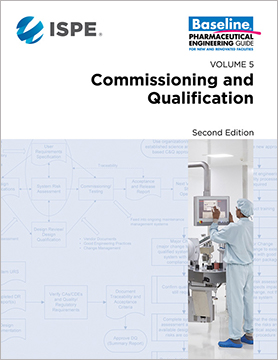Science and Risk-based Commissioning and Qualification - Applying the ISPE Baseline Guide, Volume-5, Second Edition: Commissioning and Qualification (T40)
Overview
Worldwide Regulatory expectations and guidance as led by FDA and the EU have stated that all Pharmaceutical Quality Systems should apply a QRM (Quality Risk Management) approach. Through interactive workshops, this course will explain and apply the science and risk-based approach to integrated lifecycle Commissioning & Qualification by conducting verification of systems, equipment and facilities in accordance with the recently issued 2nd Edition Guide, ICH documents Q8 (R2), Q9, and Q10, current Regulatory Guidance, industry best practices, and ASTM E2500.
NOTE: It is strongly recommended that participants be familiar with basic concepts of commissioning and qualification prior to attending this course.
What You Will Learn
- Applying the QRM C&Q Process Flow
- Principles, activities, and deliverables that constitute an efficient and acceptable approach to demonstrating facility and equipment fitness-for-use/qualification as required by major global regulatory authorities;
- Improving the ability to consistently meet documented process requirements;
- Controlling risks within the manufacturing process;
- Producing high-quality products and consistent operation to meet product user requirements.
- Guidance is provided on how to transition an organization's approach quality systems and establishing the appropriate of level of quality oversight for Commissioning and Qualification that incorporates a science and risk-based approach
Resources and Activities
- Pre-Course Work Materials
- This course was developed with input by members of the ISPE Commissioning and Qualification COP and the 2nd Edition Guide Draft Team.
- Interactive Exercises
- Learning Assessments
- Baseline Guide Vol 5: Commissioning & Qualification 2nd Edition
Course Modules
- “Fitness-For-Use” Qualification of the Commercial Manufacturing Process
- User Requirements, Critical Aspects, and Critical Design Elements
- C&Q/ (Verification) Planning
- System Classification
- GEP and the Engineering Quality Process (EQP)
- Change Management
- Quality Risk Management (QRM)
- Design Reviews / Design Qualification
- Verification/(C&Q) Execution
- Acceptance and Release
- Vendor Audits
- Good Documentation Practices for GEP
- Alignment with GAMP 5 for Process Control Systems
- QRM C&Q Program Implementation and Legacy Systems
- Composite Matrix for Requirement, Traceability, DQ and Testing
Who Should Attend
- Intermediate practitioners of Commissioning and Qualification who want to understand and use the Science and Risk-based approach.
- Project engineers, project managers, commissioning and validation professionals, engineering service providers, and quality assurance personnel involved in qualification and validation and regulatory.
Additional Course Details
Implementing ASTM Standard for Verification
Applying the principles of ICH Q9 (Quality Risk Management) and ASTM E2500-07 ensures GMP facilities and equipment are "fit for use," perform satisfactorily, and may be used in the manufacturing, processing, packaging, and holding of a drug. This webinar reviews this approach and identifies critical aspects of manufacturing systems that will provide the focus for qualification/verification activities and allow for Good Engineering/Commissioning Practices to apply throughout the project lifecycle.
Learning Objectives:
- Relate the ASTM Standard to GMP regulations and guidance documents
- Explain the regulatory foundation for the risk-based approach
- Understand the 2001 ISPE Baseline® Guide: Commissioning and Qualification and how it links to new concepts in the ISPE Guide: Science and Risk-Based Approach for the Delivery of Facilities, Systems, and Equipment
- Differentiate qualification versus verification
- Differentiate between the new risk assessment approach versus the old one
- Understand how the new USFDA Process Validation links to ASTM E2500
- Understand the details on verification process flow
- Implement verification through the C&Q process (FAT, SAT, IV, FV, PT)
- Understand ways GEP can be used as a foundation for verification
- Understand the relationship between ICH Q9, ASTM E2500, and ISPE Baseline Guide, Volume 5, 2nd Edition: Commissioning and Qualification.
- Discuss the information necessary to develop Requirements Documents that will support a science and risk-based approach to focus the qualification effort. Given the necessary information and a list of requirements, identify those that are necessary for product quality and those that are business/safety related.
- Apply risk management throughout the design and verification phases. Explain the link between risk assessments, design review, and quality risk management.
- Understand and examine the development of a C&Q/Verification Strategy that incorporates use of vendor testing, construction quality assurance, site acceptance testing, installation checks, and functional testing.
- Know what is involved in a system Acceptance and Release report given requirements, critical aspects/critical design elements, and verification test results in compliance with a verification strategy.
- Outline the use of GAMP® 5 principles in support of system delivery of a packaged system inclusive of mechanical and control system elements.
- Summarize US / EU / SFDA / and WHO regulatory requirements and expectations that may influence application of a science and risk-based approach.
Community of Practice (COP)
This training course is of particular interest to existing and future members of the following ISPE Commissioning and Qualification Communities of Practice (COP).

